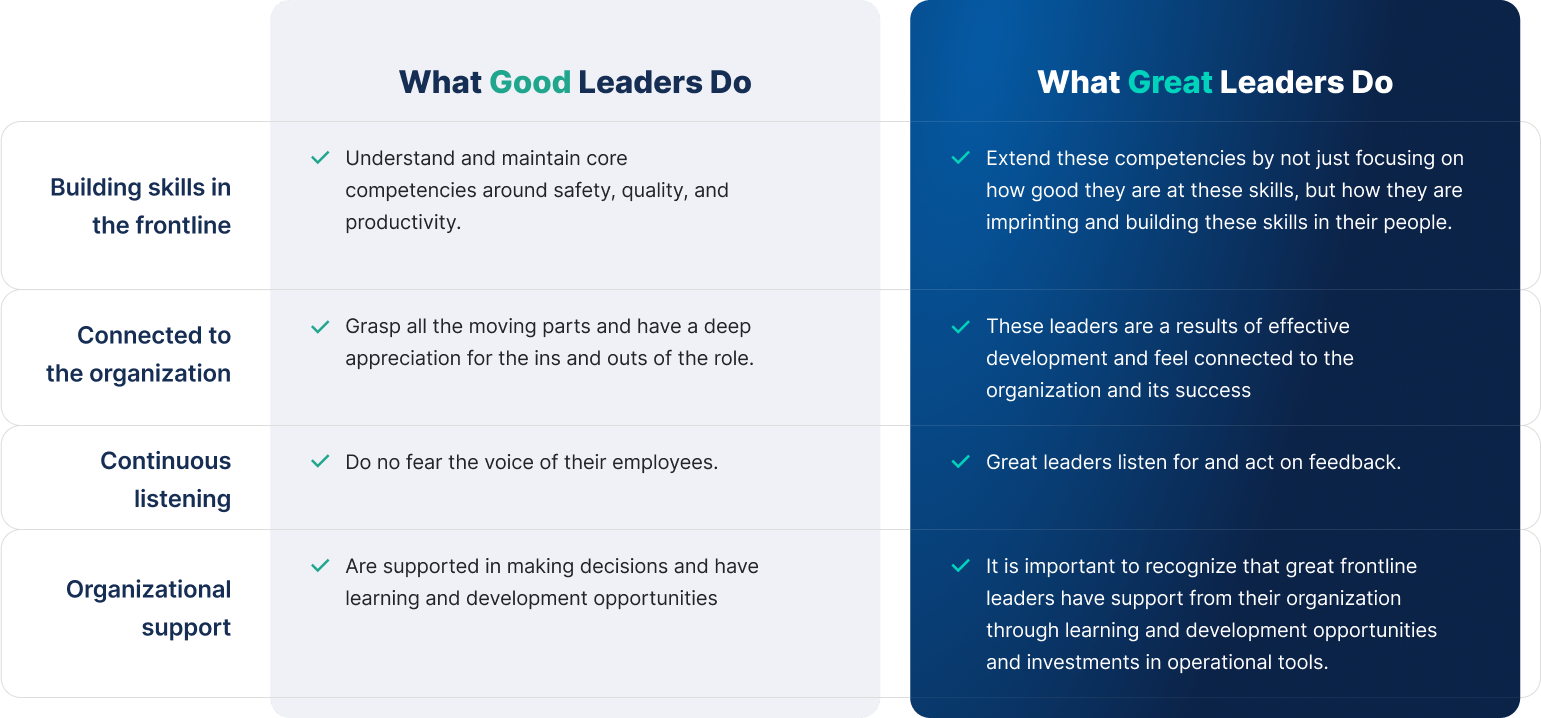How to develop frontline leaders & site managers
Better managers lead to better business outcomes. This is the one-stop shop for operations leaders to find tools designed to help develop frontline managers, leading to improved operational performance, labor management, quality assurance, and workplace safety.
The importance of frontline leaders for effective operations management
To understand how to develop frontline leaders and site managers, organizations need to first grasp the importance. Effective operations management relies on frontline workforce productivity, quality assurance, workplace safety, macroeconomic disruptions, and union risks. All of these key areas involve people. And people need leadership.
The best leaders do more than just create skilled employees. They align teams and motivate them to achieve great results, by solving challenges together and creating growth opportunities. Better managers drive better business outcomes.
Recognizing the gap in practical, actionable resources for operations leaders, we partnered with Chris Johnson, Senior Director of Human Resources at Ferguson Enterprises to create a toolkit that not only guides but also encourages active participation from all involved personnel.
This toolkit was designed to equip frontline operation leaders and site managers with development resources. We will also help answer key questions such as:
- What makes a good frontline leader?
- What’s the right approach to frontline leadership development?
- How can I give and receive feedback?
- What’s the right way to measure and enhance leadership effectiveness?
- What are some practice tips I can reference?
Keep reading to get these answers or skip right to the toolkit.
Why frontline leadership matters in operational excellence
Operational excellence requires a focus on increasing efficiency, reducing waste and costs, and improving quality and customer satisfaction. Frontline leadership matters because it aligns the frontline workforce to these goals and eliminates challenges like turnover that can lead to even more operational challenges.
You’ve probably heard the saying, “people don’t leave bad jobs, they leave bad managers.” While there may be some truth in that, data shows frontline workers are leaving jobs at a record rate for more specific reasons. These include:
Career advancement: Frontline workers want upward mobility. According to more than 18,000 frontline workers across 150 companies, lack of career growth is the No. 1 reason for turnover.
Lack of proper training: Nearly half of frontline workers looking to quit their jobs cite lack of proper training as a significant factor.
Burn-out: Especially after the Covid-19 pandemic, there have been more signs of burn-out for the frontline. More than half of the frontline workforce notes that they feel burned out.
Communication: Communication is critical for engagement, safety, and operational excellence and frontline workers often note that it is lacking.
While turnover can’t always be directly attributed to “bad managers”, these top reasons for turnover and lack of engagement can be fixed and even avoided with strong leadership.
Organizations that prioritize training and development as part of their culture cultivate effective frontline managers and site leaders. Good frontline managers and site leaders can recognize gaps in training and advocate for a plan to fix them. A skilled supervisor can better recognize the signs of burnout and manage their team more effectively. Lastly, clear and consistent, two-way communication between leaders, managers, and the frontline leads to swift issue resolution and fosters a safer and more inclusive work environment, increasing employee satisfaction and loyalty.
Simply put, frontline leadership matters because organizations with strong frontline leadership have higher operational performance, productivity, employee engagement, and retention.
When organizations fail to prioritize leadership development, they often promote their top performers without considering whether they possess the necessary skills to lead effectively. Implementing tailored training programs and establishing specific criteria for promotions can ensure that the leadership team is both well-rounded and capable. This approach fosters better team management and cultivates a culture of continuous improvement. Effective frontline leadership is essential for managing unexpected challenges and fostering an environment of listening, learning, and growth.
TOOLKIT
Get access to the leadership scorecard
Help your leaders and managers agree on leadership competencies and identify potential gaps that are hindering your frontline
Key traits of effective operations leaders
The best frontline leaders have strong communication skills, decision-making abilities, and adaptability. But what sets apart good frontline leaders from great frontline leaders – the leaders who achieve operational excellence?
Building skills in the frontline: Good frontline leaders understand and maintain core competencies around safety, quality, and productivity. Great frontline leaders extend these competencies by not just focusing on how good they are at these skills, but how they are imprinting and building these skills in their people.
Connected to the organization: Good frontline leaders understand all the moving parts and have a deep appreciation for the ins and outs of the role. Great frontline leaders, however, are not usually created by accident, but instead are the result of an organization’s effective leadership development. These leaders had time invested into their development and training to help them feel connected to the organization and understand the impact they and their team have on the overall success of the organization.
Continuous listening: True operations leaders do not fear the voice of their employees. Good leaders embrace it, great leaders listen and act on it.
Organizational support: It is important to recognize that great frontline leaders have support from their organization through learning and development opportunities and investments in operational tools. Great operations leaders have the technology and support they need to help them:
- Make informed decisions to quickly mitigate risks
- Celebrate safety adherences and best practices
- Identify skill gaps and train the frontline workforce, ensuring safety, quality, and productivity
- Continuously listen, and act on feedback
- Understand labor management challenges and the impact that has on operations
- Share the mission and vision of the organization so everyone understands the impact and importance of their role
Now that you understand the difference between good and great frontline managers, WorkStep can help you identify leadership strengths and coaching needs.
TOOLKIT
Get the best survey questions to identify the top leaders
Not sure if your leaders are terrible, good, or great? Know the questions to ask in your next frontline survey.
DOWNLOAD THE BEST SURVEY QUESTIONS
Approach to developing operations leadership
Immersive learning experiences are an effective strategy frontline leaders can utilize in their development. These targeted trainings, typically occurring over a several-week period, use interactive methods such as role-playing, group discussions, and hands-on activities to engage participants and facilitate deeper learning. By actively involving leaders in these activities, they can practice their skills in a supportive environment, and enhance their understanding of complex concepts. Real-world scenarios and case studies can help leaders apply theoretical knowledge to practical situations, making learning relevant and immediately applicable.
While there are many approaches to frontline leadership development, Chris Johnson recently shared with us details on the effective approach Ferguson Enterprises is taking. Chris shared that, “Engaging in real-time scenarios and receiving ongoing feedback helps leaders understand their roles better and develop effective strategies for team management.”
Leveraging feedback for leadership growth and development
WorkStep provides a robust feedback tool that empowers companies and their operations leaders to shape targeted training and development opportunities. Leveraging data from WorkStep’s platform, these opportunities are informed by real-time insights into workforce sentiments, productivity drivers, and operational challenges. This feedback-driven approach ensures that training initiatives are tailored to address specific needs identified through comprehensive data analysis. This enables frontline leaders to implement strategies that drive performance improvements and enhance employee satisfaction across their teams.
TOOLKIT
Get access to a leadership sample simulation outline
Not sure how your leaders will handle interactions with their frontline? Use this outline to help facilitate leadership development workshops and trainings.
If training and development programs are designed to solve problems and address gaps, data and feedback are critical. Tools cover various aspects, including manager relationships and team dynamics, providing a thorough understanding of workforce sentiments. Continuous feedback enables leaders to refine their approaches and address emerging issues quickly. Leadership development programs thrive on this ongoing feedback loop, supported by WorkStep’s platform that provides timely insights for proactive leadership, enabling early intervention to prevent employee turnover.
Development strategies and data-driven decision making
Timely insights are crucial for leadership growth, empowering leaders to make informed decisions. WorkStep facilitates leadership development by granting access to immediate employee feedback, enabling leaders to continually refine strategies and methods. This direct feedback loop helps leaders stay responsive to workforce needs, fostering a culture of ongoing improvement. By analyzing this information, leaders can take targeted actions that address specific issues, thereby enhancing workforce productivity and satisfaction. Data-driven insights empower leaders to make informed decisions that drive organizational success and reduce turnover, ensuring sustained growth and stability.
Measuring and enhancing leadership effectiveness
For leaders in HR, operations, and executive roles to drive meaningful change, they require measurable indicators to assess and enhance their leadership practices.
It is important to define specific KPIs that indicate effective leadership. Examples include:
- Team productivity metrics: Effective leaders drive their teams to achieve high productivity levels. Metrics such as output per employee, on-time delivery rates, and quality control scores can highlight the efficiency and effectiveness of leadership practices.
- Employee Safety Observations: Effective leaders encourage and facilitate regular safety observations by employees, fostering a proactive safety culture. Metrics such as the number and quality of safety observations and suggestions can indicate the level of employee engagement and the effectiveness of leadership in promoting a safe workplace.
- Retention rates: A high retention rate is a strong indicator of effective leadership. Tracking how many employees stay with the company over a specific period helps assess leadership’s impact on employee loyalty and satisfaction.
- Employee engagement levels: Engagement is a critical measurement of how motivated and committed employees are. Regular check-ins and feedback tools can help gauge engagement levels, reflecting the effectiveness of leadership practices.
- Diversity, equity, and inclusion (DEI) metrics: Prioritizing DEI initiatives leads to higher retention rates and a more inclusive workplace. Tracking these metrics helps evaluate the success of leadership in fostering an equitable work environment.
WorkStep’s dashboards offer real-time data on KPIs such as employee satisfaction, turnover, and retention rates, so that leaders can make immediate and informed decisions to address emerging issues. Tailored reports for specific roles, departments, or facilities provide targeted and effective leadership insights, highlighting areas that need attention and opportunities for improvement. By focusing on these KPIs and utilizing WorkStep’s dashboards, leaders can improve their effectiveness, grow employee satisfaction, and achieve sustainable business success.
Organizational success relies on leadership initiatives that prioritize employee well-being, recognition, and career development. Effectively managing employee engagement has a significant impact on employee retention rates and reduced turnover costs. A data-driven approach to employee engagement enables leaders to proactively nurture employee satisfaction and lead teams toward achievable goals. With access to real-time data and feedback through WorkStep’s dashboards, leaders empower every employee to be actively engaged in their team’s success.
Practical tips and advice for operations leaders
Going back to why frontline leadership matters, the frontline workforce is seeking strong leadership, communication, training, and career advancement. Here are practical tips for operations leaders to infuse learning and development into daily operations without compromising productivity, quality, or safety.
Tip 1: Prioritize ongoing learning initiatives
Operational leaders can cultivate a dynamic environment where team members are encouraged to expand their skills and knowledge. This culture not only boosts employee engagement but also demonstrates organizational commitment to personal and professional growth.
A key benefit of a learning culture is its ability to promote continuous improvement. When teams are encouraged to learn and innovate, they become more adept at identifying inefficiencies and implementing solutions. By investing in training programs tailored to operational needs and leveraging feedback mechanisms like employee surveys and performance metrics, leaders can ensure that learning efforts are targeted and effective.
Tip 2: Identify opportunities for mentorship and coaching
By providing junior team members with guidance from experienced leaders, these programs nurture leadership potential and promote collaboration across all levels of experience within the organization. Experienced mentors not only offer insights but also serve as role models, inspiring team members to strive for excellence and take ownership of their professional development.
Tip 3: Know leadership matters for successful operations
Challenge yourself as a leader, and make sure that you have strong leaders within your organization. WorkStep can help you identify strong and weak leaders. Something very important for measuring and fixing in as close to real-time as possible.
Developing skilled frontline leaders and site managers is crucial for operational success. These leaders play a pivotal role in driving productivity, ensuring quality assurance, and maintaining workplace safety amidst evolving challenges like union risks and macroeconomic disruptions. This toolkit equips operations leaders with essential resources to cultivate effective leadership through targeted training, mentorship, and continuous learning initiatives. By empowering frontline managers to innovate and adapt, organizations can achieve better business outcomes, enhance operational performance, and foster a resilient workforce ready to tackle future challenges.
TOOLKIT
Get access to the frontline leadership development toolkit
The Frontline Leader Development Toolkit resources will help you identify gaps and opportunities for aligning your team to improve overall operations and productivity.
Download to gain access to:
Sample survey questions: Key engagement survey questions to identify strong and weak leaders
Training guide: Sample role-playing exercise for the frontline workforce
Leadership template: How to have leadership conversations
Read more about frontline leadership
Download the frontline leadership development toolkit
The Frontline Leadership Development Toolkit resources will help you transform your frontline leaders and increase your frontlines productivity.
Download to gain access to:
Sample survey questions: Key engagement survey questions to identify strong and weak leaders
Training guide: Sample role-playing exercise for the frontline workforce
Leadership template: How to have leadership conversations




